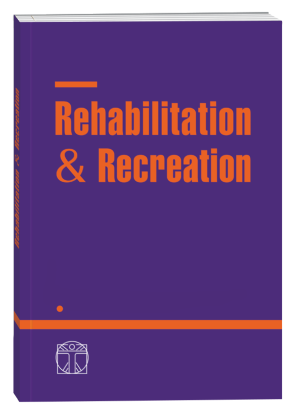REHABILITATION OF PATIENTS WITH CHRONIC HEART FAILURE AGAINST THE BACKGROUND OF THE METABOLIC SYNDROME
DOI:
https://doi.org/10.32782/2522-1795.2023.17.15Keywords:
chronic heart failure, metabolic syndrome, physical rehabilitation, quality of life.Abstract
The purpose of the study is to study the impact of a comprehensive physical rehabilitation program on the condition of patients with a combination of chronic heart failure and metabolic syndrome. Research materials and methods. In order to study the relationship between indicators characterizing chronic heart failure (functional class, six-minute walk test, Borg scale) and components of the metabolic syndrome (waist circumference, body mass index, blood pressure, triglycerides, cholesterol), a study of two groups was conducted patients: the first group (experimental) – patients with chronic heart failure without metabolic syndrome, the second group (control) – patients with chronic heart failure with metabolic syndrome. Research results. The method of physical exercises depends on the stage of the disease, the degree of blood circulation insufficiency, and the state of the coronary blood supply. In case of severe manifestations of the disease, pronounced heart failure or coronary circulation, the classes are designed to primarily provide a therapeutic effect: prevent complications by improving peripheral blood circulation and breathing, compensate for weakened heart function due to the activation of extracardiac factors of blood circulation, improve trophic processes, stimulate blood supply to the myocardium. For this, physical exercises of low intensity, at a slow pace for small muscle groups, breathing exercises and exercises for muscle relaxation were used. The results of the examination at the end of the study proved the beneficial effect of the proposed rehabilitation program on exercise tolerance and, as a result, on the quality of life. Against the background of physical rehabilitation, the study also obtained positive dynamics of lipid profile indicators in patients of the experimental group. Conclusions. The use of a comprehensive physical rehabilitation program in patients with chronic heart failure, which includes elements of patient education adapted to take into account the metabolic syndrome, contributes to increasing the clinical effectiveness of restorative therapy and preventing the progression of chronic heart failure, as well as correcting the components of the metabolic syndrome and improving the quality of life of such patients.
References
Григус І.М., Брега Л.Б. Фізична терапія в кардіології : навчальний посібник. Рівне : НУВГП, 2018. 268 с.
Жадан А.В. Фізична реабілітація при серцевій недостатності. Ліки України. 2019. № 7(233). С. 57–62. https://doi.org/10.37987/1997-9894.2019.7(233).187001.
Калмикова Ю.С. Сучасний погляд на проблему використання способу життя як засобу немедикаментозної терапії метаболічного синдрому. Rehabilitation & recreation. 2023. № 16. С. 37–45. https://doi.org/10.32782/2522-1795.2023.16.5.
Михайловська Н.С., Кулинич Т.О. Реабілітація пацієнтів із захворюваннями серцево-судинної системи в практиці сімейного лікаря :
навчальний посібник для студентів VІ курсу медичного факультету за програмою навчальної дисципліни «Загальна практика – сімейна медицина», спеціальності «Медицина» і «Педіатрія». Запоріжжя : ЗДМУ, 2021. 188 с.
Швед М.І., Левицька Л.В. Сучасні стратегії лікування та реабілітації хворих на інфаркт міокарда. Київ : Медкнига, 2015. 152 с.
Швед М.І., Левицька Л.В. Сучасні технології та методи кардіореабілітації. Київ : Медкнига, 2016. 144 с.
Швесткова О., Сладкова П. та кол. Фізична терапія: Підручник. Київ, 2019. 272 с.
Шумаков В.О., Малиновська І.Е., Бабій Л.М., Терещенко Н.М. Реабілітація пацієнтів із серцево-судинними захворюваннями:
історичні віхи, сучасні підходи, місце в клінічній практиці та виклики. Український кардіологічний журнал. 2019. № 26(4). С. 44–55.
Bozkurt B., Fonarow G.C., Goldberg L.R., Guglin M., Josephson R.A., Forman D.E., Lin G., Lindenfeld J., O'Connor C., Panjrath G., Piña IL., Shah T., Sinha S.S., Wolfel E. ACC’s Heart Failure and Transplant Section and Leadership Council. Cardiac Rehabilitation for Patients With Heart Failure: JACC Expert Panel. J Am Coll Cardiol. 2021. № 23;77(11). С. 1454–1469. DOI: 10.1016/j.jacc.2021.01.030.
Mahlovanyy A., Grygus I., Kunynets O., Hrynovets V., Ripetska O., Hrynovets I., Buchkovska A., Mahlovana G. Formation of the mental
component of the personality structure using physical activity. Journal of Physical Education and Sport. 2021. Vol 21 (Suppl. issue 5). P. 3053–3059.
Maikova T., Afanasiev S., Afanasieva O., Kashuba V., Andrieieva O., Grygus I., Sierpinska L., Dovgan O. Effect of physical therapy on
the oxidative homeostasis state in women with metabolic syndrome. Journal of Physical Education and Sport. 2021. Vol 21 (Suppl. issue 5). P. 3060–3067.
Nesterchuk N., Grygus I., Ievtukh M., Kudriavtsev A., Sokolowski D. Impact of the wellness programme on the students’ quality of
life. Journal of Physical Education and Sport. 2020. Vol 20 (Supplement issue 2). P. 929–938.
Silveira Rossi J.L., Barbalho S.M., Reverete de Araujo R., Bechara M.D., Sloan K.P., Sloan L.A. Metabolic syndrome and cardiovascular
diseases: Going beyond traditional risk factors. Diabetes Metab Res Rev. 2022. № 38(3). 3502. DOI: 10.1002/dmrr.3502. Epub 2021 Oct
PMID: 34614543.
Van Der Hoef C.C.S., Boorsma E.M., Emmens J.E., Mordi I.R., Dihoum A., Lang C.C., Voors A.A. UMCG cardiology research institute. Biomarker profiles and pathophysiological pathways in patients with chronic heart failure and metabolic syndrome. European Heart Journal.
Volume 43. Issue Supplement 2,ehac544.752. https://doi.org/10.1093/eurheartj/ehac544.752
Downloads
Published
How to Cite
Issue
Section
License

This work is licensed under a Creative Commons Attribution-NonCommercial-NoDerivatives 4.0 International License.











